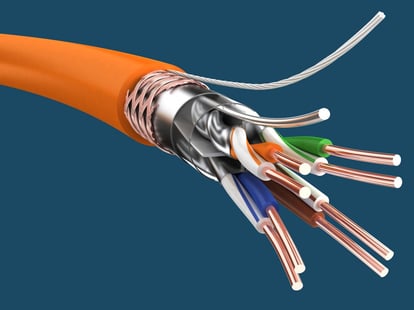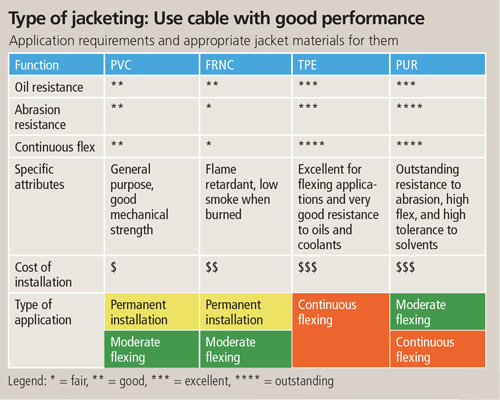This excerpt is from the September/October 2014 issue of InTech magazine and was written by Loredana Coscotin, of Belden.
In 2013, the Ethernet cable celebrated its 40th birthday. The once simple cable has evolved into the foundation of modern Internet and global connectivity. Ethernet networking has gained momentum and popularity, penetrating lots of industrial applications, such as manufacturing,  power utilities, oil and gas, and transportation. This includes energy-exhaustive machines, such as motor control centers, robots, mobile machines, and heavy equipment. Cabling in these environments can be difficult to install, requiring extra protection and resilience.
power utilities, oil and gas, and transportation. This includes energy-exhaustive machines, such as motor control centers, robots, mobile machines, and heavy equipment. Cabling in these environments can be difficult to install, requiring extra protection and resilience.
Proper cable installation is critical to maintaining uptime. Network components and media are the cause of more than 70 percent of all network faults, with operating systems accounting for less than 20 percent and application programs for the rest. The costs of the components are minimal compared to that of a network failure, where downtime costs can be measured in thousands of dollars per minute.
One recent example of network failure should help add perspective. When the installation of a fire protection system, including cabling, for a large power generation plant did not work, heads turned to the contractor upon network examination. The contractor had installed 2.485 miles of speaker wire instead of the industrial Ethernet twisted-pair cable specified by the engineers. Their reasoning, “It looked the same as the other wire!” Inevitably, the contractor paid the final price by having to go back, pull out the wire, replace it, and pay for the replacement expenses.
The bottom line? Network designers and engineers need to concentrate on building the hardware foundation for the entire network infrastructure.
Communication. Communication. Communication.
Those designing communications infrastructure should pay attention to switches, cables, and connectors. Although each is critical in its own right, users of these components need to evaluate the entire network communication system to recognize where failures are most likely to occur, as well as the costs of these failures in downtime, repairs, and replacements.
 Communications and control networks are expected to operate consistently and reliably in all types of environments. But, in mission-critical applications and extreme environments, industrial networked communications systems should be extremely rugged and robust. Any physical deterioration or electrical failure in key data transmission components can lead to defective network performance and safety issues, ultimately leading to loss of critical data, costly downtime, or even catastrophic failure.
Communications and control networks are expected to operate consistently and reliably in all types of environments. But, in mission-critical applications and extreme environments, industrial networked communications systems should be extremely rugged and robust. Any physical deterioration or electrical failure in key data transmission components can lead to defective network performance and safety issues, ultimately leading to loss of critical data, costly downtime, or even catastrophic failure.
Before selecting an industrial Ethernet cable, it is important to understand your network’s environment. Each industrial facility is different—one size does not fit all.
Industrial applications require industrial cable
In a typical office setting, the Ethernet infrastructure is installed in a relatively clean, quiet environment with cables hidden behind walls, in ceilings, and under floors, while network switches, hardware, and connectivity components are sheltered in protected areas. Industrial facilities present a very different reality.
Most cables, connectors, switches, and active network components are integral to machine automation, instrumentation, and industrial control systems—so they may need to be in harsh and potentially hazardous situations. Even the best commercial-off-the-shelf Ethernet systems are not made to handle such conditions over time. Rigorous conditions call for ruggedized cables—only industrial-grade Ethernet system components are tough enough to withstand the hazards and risks they are exposed to daily.
To connect the individual components of an industrial network—from the cabinet, through the telecommunications room to the factory floor, to the actual machine—companies need to select an industrial Ethernet cable and connectivity solution that ensures the highest level of reliability, quality, and performance. Products need to be suitable for high-abrasion locations facing direct contact with oil and solvents, taking account of electromagnetic interference (EMI), high operating temperatures, ambient temperatures, power/voltage fluctuations, machine vibration, mechanical hazards, and more.
Click here to view the complete article at InTech magazine.
About the Author Loredana Coscotin is responsible for all vertical marketing related to Belden’s portfolio of industrial cables, including the company’s DataTuff range. With a master’s degree in strategic marketing from the University of Maastricht, Coscotin joined Belden in 2011. Before her current post, she held various positions in Belden’s marketing department, most recently as product manager for fire alarm and circuit integrity cables, where she gained an in-depth understanding of data transfer in mission-critical applications.
Loredana Coscotin is responsible for all vertical marketing related to Belden’s portfolio of industrial cables, including the company’s DataTuff range. With a master’s degree in strategic marketing from the University of Maastricht, Coscotin joined Belden in 2011. Before her current post, she held various positions in Belden’s marketing department, most recently as product manager for fire alarm and circuit integrity cables, where she gained an in-depth understanding of data transfer in mission-critical applications.
Connect with Loredana:![]()



